MAJOR PINEAPPLE PRODUCING COUNTRIES PHILIPPINES, BRAZIL, COSTA RICA, THAILAND AND CHINA WITH GHANA AT THE 26 POSITION
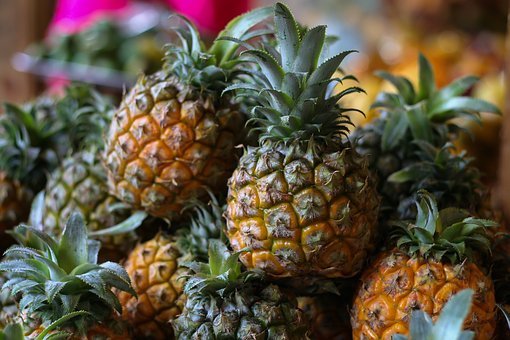
The pineapple (Ananas comosus) is a tropical plant with an edible multiple fruit consisting of coalesced berries, also called pineapples, and the most economically significant plant in the family Bromeliaceae. Pineapples may be cultivated from the offset produced at the top of the fruit, possibly flowering in five to ten months and fruiting in the following six months. Pineapples do not ripen significantly after harvest. In 2016, Costa Rica, Brazil, and the Philippines accounted for nearly one-third of the world's production of pineapples
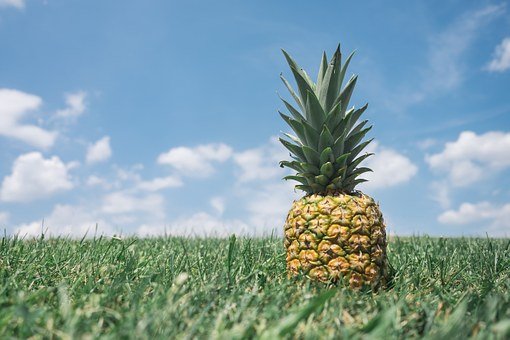
Major Pineapple producing countries PC (c) Cultivated varieties Pineapple is produced worldwide and some of the major producing countries include, Philippines, Brazil, Costa Rica, Thailand and China with Ghana at the 26 position on international market as at 2013

The pineapple is an herbaceous perennial, which grows to 1.0 to 1.5 m (3.3 to 4.9 ft) tall, although sometimes it can be taller. In appearance, the plant has a short, stocky stem with tough, waxy leaves. When creating its fruit, it usually produces up to 200 flowers, although some large-fruited cultivars can exceed this. Once it flowers, the individual fruits of the flowers join together to create what is commonly referred to as a pineapple. After the first fruit is produced, side shoots (called 'suckers' by commercial growers) are produced in the leaf axils of the main stem. These may be removed for propagation, or left to produce additional fruits on the original plant.
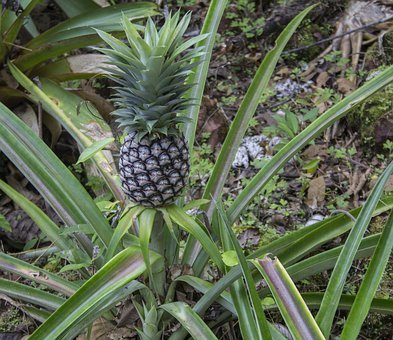
Commercially, suckers that appear around the base are cultivated. It has 30 or more long, narrow, fleshy, trough-shaped leaves with sharp spines along the margins that are 30 to 100 cm (1.0 to 3.3 ft) long, surrounding a thick stem. In the first year of growth, the axis lengthens and thickens, bearing numerous leaves in close spirals. After 12 to 20 months, the stem grows into a spike-like inflorescence up to 15 cm (6 in) long with over 100 spirally arranged, trimerous flowers, each subtended by a bract. Flower colors vary, depending on variety, from lavender, through light purple to red.
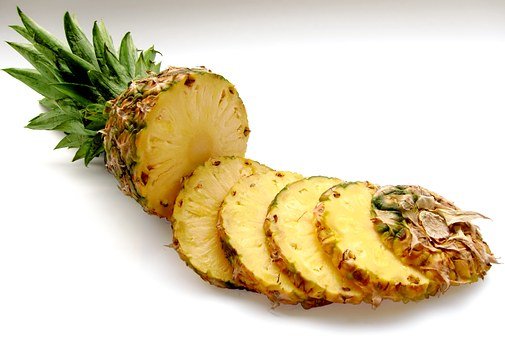
The plant is indigenous to South America and is said to originate from the area between southern Brazil and Paraguay; however, little is known about the origin of the domesticated pineapple (Pickersgill, 1976). MS Bertoni (1919) considered the Paraná–Paraguay River drainages to be the place of origin of A. comosus.

The natives of southern Brazil and Paraguay spread the pineapple throughout South America, and it eventually reached the Caribbean, Central America, and Mexico, where it was cultivated by the Mayas and the Aztecs. Columbus encountered the pineapple in 1493 on the leeward island of Guadeloupe. He called it piña de Indes, meaning "pine of the Indians", and brought it back with him to Spain, thus making the pineapple the first bromeliad to be introduced by humans outside of the New World.] The Spanish introduced it into the Philippines, Hawaii (introduced in the early 19th century, first commercial plantation 1886), Zimbabwe, and Guam.

The fruit is said to have been first introduced in Hawaii when a Spanish ship brought it there in the 1500s. The Portuguese took the fruit from Brazil and introduced it into India by 1550.
IMPROVES BLOOD CIRCULATION
Along with the vasodilating potential of potassium, pineapple also provides the body with copper, another essential mineral that functions in a number of enzymatic reactions and compounds in the body. Most notably, copper is a necessary element for the formation of healthy red blood cells. High red blood cell count increases oxygenation to various organs and makes them function at optimal levels. It also increases cognitive abilities and maintains neural pathways to prevent disorders like dementia and Alzheimer’s disease.
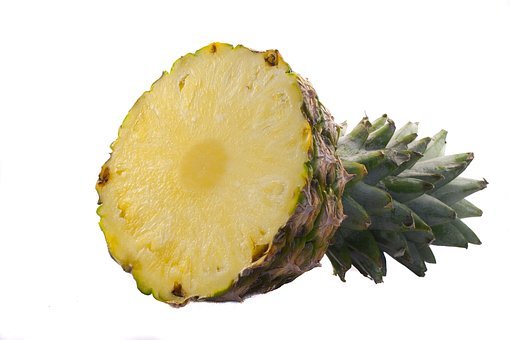
DISSOLVES KIDNEY STONES
By regulating digestion and reducing blood clotting, pineapples help in dissolving kidney stones. Eat the bromelain-rich fruit or drink its juice to keep the kidneys safe and stones away!
PROTECTS HEART HEALTH
The vasodilating properties of potassium in pineapple can prevent clots from blocking the flow of blood and reduce the accumulation of plaque in the arteries and vessels. This helps prevent conditions like atherosclerosis, heart attacks, and strokes. So, eat pineapples for a healthy heart!
CONTROLS DIABETES
Pineapple, being rich in fiber, is a great food for diabetics. For those with type 1 diabetes, it aids in lowering the high blood glucose levels. And in individuals with type 2 diabetes, it results in improved blood sugar, insulin, and lipid levels. However, there is a certain amount of sugar present in pineapples, so do limit your intake to avoid adverse effects.
INCREASES FERTILITY
Pineapples have been connected to improved fertility because of their antioxidant properties. These crowned fruits exercise their free radical scavenging action and help women in conceiving. The vitamins and minerals like vitamin C, beta-carotene, copper, zinc, and folate, all play an essential part in improving female as well as male fertility.
SKIN CARE
Vitamin C, present in pineapple, is a super antioxidant that tones your skin. It also helps clear acne, fight skin damage, and delay aging by reducing the appearance of wrinkles. Moreover, collagen formation is largely credited to vitamin C, which indirectly keeps the skin tissues healthy.
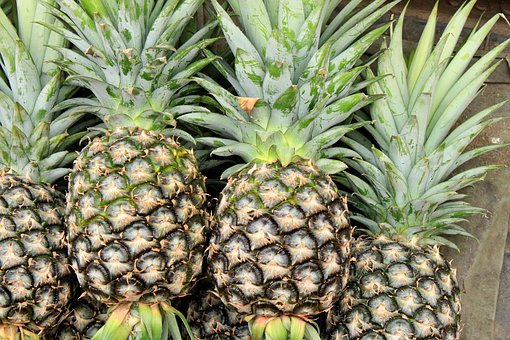
IMPROVES ORAL HEALTH
Along with the antioxidants that protect against oral cancer, pineapple also has astringent properties, which strengthen gums and teeth. Pineapple is a very powerful astringent and is often prescribed as a natural remedy to fix the loosening of teeth or the retraction of gums. Astringent agents help tighten up tissues and tone the body so that tooth loss, hair loss, muscle weakness, and skin loosening do not occur.
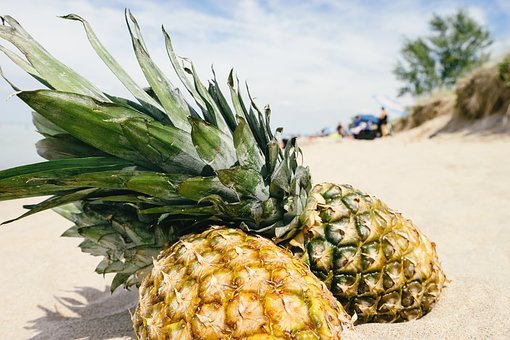
IMPROVES VISION
Pineapple has the ability to improve eye health and prevent other age-related eye diseases. Macular degeneration affects many elderly people and beta-carotene present in pineapple can help prevent this vision problem.

REGULATES BLOOD PRESSURE
Pineapple is a valuable source of potassium. The vasodilating action of potassium eases tension and stressin the blood vessels and increases blood circulation to various parts of the body. When your blood vessels relax, the blood pressure is reduced and the flow of blood is less restricted. Therefore, your chances of suffering from hypertension are reduced.

IMPROVES BONE HEALTH
Pineapple contains an impressive amount of manganese. Manganese is a trace mineral essential for the strengthening of bones as well as their growth and repair. It is the most prominent mineral in pineapple, and a single serving can provide you with more than 70% of your daily requirement of this mineral.
26th on the list is goo but we can do better!!
Try to add more originality as Cheetah is actually here to let you know that your post is partly plagiarized or unoriginal...
Resteemed your article. This article was resteemed because you are part of the New Steemians project. You can learn more about it here: https://steemit.com/introduceyourself/@gaman/new-steemians-project-launch